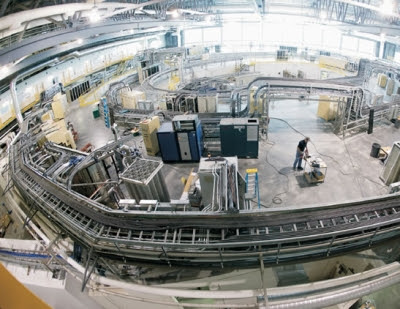 The Canadian Light Source (CLS) is a third generation 2.9 giga electron volt synchrotron located in Saskatoon, Saskatchewan, Canada. It opened on October 22, 2004 after three years of construction and cost C$173.5 million. One of only 17 such facilities in the world, it occupies a footprint the size of a football field on the grounds of the University of Saskatchewan. The CLS is operated by CLS Inc. a not-for-profit corporation owned by the University of Saskatchewan.
The Canadian Light Source (CLS) is a third generation 2.9 giga electron volt synchrotron located in Saskatoon, Saskatchewan, Canada. It opened on October 22, 2004 after three years of construction and cost C$173.5 million. One of only 17 such facilities in the world, it occupies a footprint the size of a football field on the grounds of the University of Saskatchewan. The CLS is operated by CLS Inc. a not-for-profit corporation owned by the University of Saskatchewan.The CLS is one of the largest science project in Canadian history, and represents an unprecedented level of cooperation between the Government of Canada, the governments of Saskatchewan, Ontario and Alberta, the City of Saskatoon, universities across Canada and industry.
 A synchrotron produces extremely bright light by using radio frequency waves to accelerate electrons to nearly the speed of light and then bending the path of the electron stream into a circle using powerful electromagnets. As they travel in their circular path, the electrons shed energy as photons across the electromagnetic spectrum including infrared, ultraviolet and X-rays. The light is shone down beamlines to endstations (small laboratories) where scientists can select different parts of the spectrum to “see” the microscopic nature of matter, right down to the level of the atom.
A synchrotron produces extremely bright light by using radio frequency waves to accelerate electrons to nearly the speed of light and then bending the path of the electron stream into a circle using powerful electromagnets. As they travel in their circular path, the electrons shed energy as photons across the electromagnetic spectrum including infrared, ultraviolet and X-rays. The light is shone down beamlines to endstations (small laboratories) where scientists can select different parts of the spectrum to “see” the microscopic nature of matter, right down to the level of the atom. Synchrotrons like the CLS can be used to probe the structure
Synchrotrons like the CLS can be used to probe the structure  of matter and analyze a host of physical, chemical, geological and biological processes. Information obtained by scientists can be used to help design new drugs, examine the structure of surfaces in order to develop more effective motor oils, biomedical imaging of tumours and other biological tissues, build more powerful computer chips, develop new materials for safer medical implants, and help with clean-up of mining wastes, to name just a few applications.
of matter and analyze a host of physical, chemical, geological and biological processes. Information obtained by scientists can be used to help design new drugs, examine the structure of surfaces in order to develop more effective motor oils, biomedical imaging of tumours and other biological tissues, build more powerful computer chips, develop new materials for safer medical implants, and help with clean-up of mining wastes, to name just a few applications. Before The CLS
Before The CLSThe first accelerator research programs at the University of Saskatchewan was established in 1948, when Canada's first betatron (a 25 MeV machine) was constructed in the Physics Building. Based on this early success in 1951 the world's first non-commercial cobalt-60 therapy unit for the treatment of cancer was constructed on campus and then in 1961 construction of the Saskatchewan Accelerator Laboratory (SAL) started and was completed in 1964. In 1999 SAL operations were discontiuned and the accelerator used as an injector for the CLS. In addition to the CLS the University continues to operate a small Tokamak as part of the Plasma Physics Laboratory.
Prior to the CLS, Canada (through the University of Western Ontario) operated several beamlines at the Synchrotron Radiation Center (SRC), at the University of Wisconsin-Madison, in Stoughton, Wisconsin.
 The CLS Project
The CLS ProjectOn March 31 1999 The Canada Foundation for Innovation provided partial funding for the construction of the CLS facility. The remaining matching funds from Saskatchewan, Ontario, Alberta, Saskatoon and industry would follow between 1999 and 2001. On September 21 1999 The CLS project was officially launched. On February 21 2001 the CLS building expansion was completed.
 The Linac was refurbished and placed back into service on September 13 2001 while the Booster Ring (BR1) and Storage Ring (SR1) were still under construction. First turn was achieved in the BR1 ring in July 2002 with BR1 fully commissioned by September 2002. First turn in the SR1 ring was achieved on September 2003, with first light in December. In April of 2004 SR1 achieved 100 mA.
The Linac was refurbished and placed back into service on September 13 2001 while the Booster Ring (BR1) and Storage Ring (SR1) were still under construction. First turn was achieved in the BR1 ring in July 2002 with BR1 fully commissioned by September 2002. First turn in the SR1 ring was achieved on September 2003, with first light in December. In April of 2004 SR1 achieved 100 mA. In 2002 the CLS Project was awarded the National Award for Exceptional Engineering Achievement by the Canadian Council of Professional Engineers.
In 2002 the CLS Project was awarded the National Award for Exceptional Engineering Achievement by the Canadian Council of Professional Engineers.The CLS Project was officially completed June 30, 2005.
Operation
On July 15 2004 CLS received regulatory approval from the CNSC for normal operation. The grand opening occurred in October 2004. On May 19 2005 Her Majesty Queen Elizabeth II (Queen of Canada) and His Royal Highness The Duke of Edinburgh visited the CLS. A few days later on May 27 the first experiment by an outside user was conducted.
*From Wikipedia, the free encyclopedia

No comments:
Post a Comment
Contact The Wizard!
(he/him)